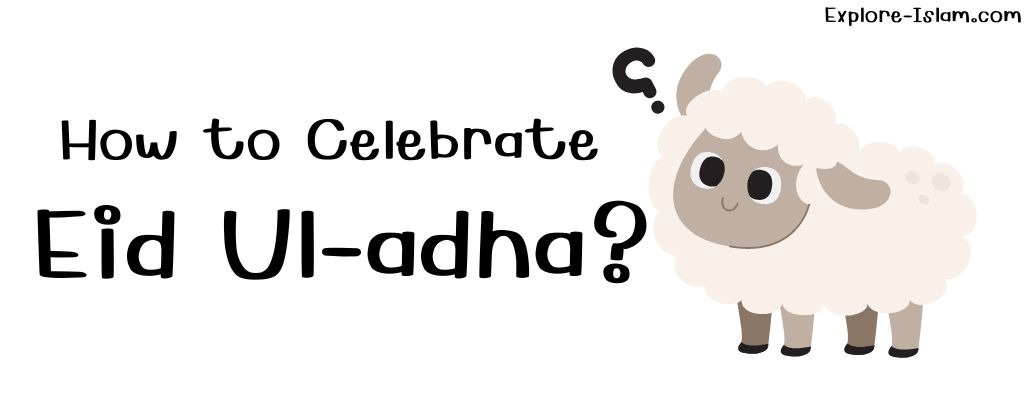Have you heard before about the Festival of Sacrifice ? It’s a very known religious celebration in Islam that refers to prophet Ibrahim and his son Ismail. Do you know why it’s called that ?
Here we will learn the following:
Festival of Sacrifice
Let’s talk more about why it’s called the Festival of Sacrifice:
The story begins when Ibrahim received a divine command from Allah (One True God) to sacrifice his son as a test of his devotion and obedience. Ibrahim, being a faithful servant, shared this revelation with his son Ismail, who willingly accepted the command without hesitation.
As Ibrahim and Ismail prepared for the sacrifice, shaitan (Satan) tried to dissuade Ibrahim from carrying out the command by whispering doubts and temptations. However, Ibrahim remained steadfast in his faith and rejected Satan’s attempts.
On the appointed day, as Ibrahim prepared to sacrifice his beloved son, Allah intervened and replaced Ismail with a ram. This act demonstrated Ibrahim’s unwavering devotion and his willingness to sacrifice everything for the sake of Allah.
How can we benefit from that amazing story ?
This story serves as a powerful reminder of trust in Allah’s will, the importance of obedience, and the value of sacrifice.
It also highlights the importance of submission to the will of Allah and serves as a source of inspiration for Muslims to uphold the principles of faith, devotion, and sacrifice in their lives.
What muslims do in this festival?
Muslims around the world commemorate this event during Eid al-Adha, which marks the end of the Hajj pilgrimage to Mecca. During the festival, Muslims offer prayers, share meals, and perform the symbolic act of sacrificing an animal to remember the act of sacrifice by Ibrahim.
How To Celebrate Eid Al Adha?
Let’s explore ten activities that reflect the meaning and significance of this auspicious occasion:
1. Sharing the Feast:
One of the central aspects of Eid al-Adha is the sharing of a festive meal. Muslims prepare delicious traditional dishes and invite family, friends, and neighbors to partake in the feast. This act of sharing promotes unity and strengthens social bonds.
2. Sacrificial Ritual:
Muslims perform a symbolic sacrifice of an animal, following the example of Prophet Ibrahim. The meat from the sacrifice is divided into three portions: one for the family, one for relatives and friends, and one for the less fortunate. This act emphasizes the importance of sharing and caring for the less privileged.
Read alos: Qurbani In Islam: animal sacrifice in islam rules in Eid Al-Adha
3. Prayer and Reflection:
Attending the special congregational prayer is an essential part of Eid al-Adha. Muslims gather at the mosque or designated prayer grounds to offer prayers of gratitude and reflection. It is a time for introspection and strengthening the spiritual connection with Allah.
Read: Can Prayer Change Your Life?
4. Dressing in Traditional Attire:
Muslims adorn themselves in traditional attire on Eid al-Adha. Donning colorful and festive clothing, both men and women showcase their cultural heritage and demonstrate a sense of joy and celebration.
5. Visiting Loved Ones:
Eid al-Adha is an occasion for families and friends to come together. People visit relatives, exchange greetings, and share meals. This practice fosters a sense of belonging, love, and unity within the community.
6. Giving Gifts:
Exchanging gifts during Eid al-Adha is a common practice, especially among family members and close friends. The act of giving gifts symbolizes appreciation, love, and the joy of sharing blessings with one another.
7. Acts of Charity:
Eid al-Adha emphasizes the importance of giving to those in need. Muslims engage in acts of charity by donating money, food, or clothing to charitable organizations or directly to individuals who are less fortunate. This act of kindness brings happiness to both the giver and the receiver.
8. Festive Decorations:
Muslims decorate their homes and surroundings with colourful lights, banners, and ornaments during Eid al-Adha. These vibrant decorations symbolize the joyous atmosphere and create a festive ambiance within the community.
9. Expressing Gratitude:
Eid al-Adha is a time to express gratitude for the blessings received. Muslims often gather with their loved ones to reflect on their blessings, share stories, and express appreciation for the abundant provisions in their lives.
Also, here are some suggested activities for kids.
For more about eid, read these:
How To Celebrate Eid in 2023 – Full Guide
Conclusion:
Eid al-Adha is a time of celebration, reflection, and acts of kindness in the Islamic faith. These ten activities highlight the essence of the occasion, emphasizing values such as sharing, gratitude, unity, and compassion. Through participating in these activities, both Muslims and non-Muslims can gain a deeper understanding of the significance of Eid al-Adha and appreciate the values that it promotes. Let us embrace the spirit of joy and harmony during this festive season and foster a sense of community and understanding. Eid Mubarak!

